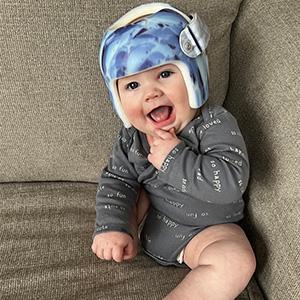Parker Rasmussen

Parker Rasmussen took his helmet in stride.
Parker’s head was a little lopsided when he was born. His pediatrician Amy Kraushaar, DO kept an eye on it. At his 2-month checkup, she noticed a flat spot, and torticollis: tightening of neck muscles on one side.
It made Parker’s parents Kristin and Taylor a little nervous. “As first-time parents, we felt like we were trying our best,” Kristin said.
Parker started physical therapy with pediatric therapist Heidi Richardson, PT – plus lots of tummy time at home.
After two months with little improvement in head shape, Heidi recommended that Parker be seen by the Plagiocephaly Clinic team to assess for a helmet. Babies who are seen by the Plagio Clinic team at NH+C’s Rehabilitation Services clinic in Northfield are assessed by a physician, physical therapist, and orthotist together.
The team recommended a helmet to reshape Parker’s head as he grew: A custom helmet has cushioning with open spaces over the flat areas, allowing the skull to grow into those open spaces and develop a rounder shape as the baby grows.
Correcting Parker’s head shape now would help prevent possible dental problems in the future, align his ears (important for wearing glasses), and ensure a safe fit for bike and sports helmets in the future.
Parker was fitted for his helmet through Orthotic Care Services at 4 months old and wore it for just under three months. “He had a tremendous growth spurt in the first two weeks that he wore it, so it was perfect time to get him into the helmet,” Kristin says. “We captured his growth at the perfect time period to make the most of the helmet treatment.”
Parker adjusted well to wearing his helmet 23 hours a day. “He got sweaty and stinky, but we figured hey, he’s probably going to play hockey in the future and he’s just breaking us in,” Kristin laughs. Parker also didn't let the helmet stop him from experiencing lots of firsts, and meeting all his developmental milestones.
At the same time, Kristin focused on PT and exercises to correct the torticollis. At first, it felt overwhelming going to PT every two weeks, and helmet measurements every two weeks – “the pressure we felt about whether we were doing the right thing,” Kristin recalls.
Support from Dr. Kraushaar and Heidi (plus orthotist Sara Marmar, CPO) helped Kristin and Taylor take Parker’s care in stride: “They’re all such great care partners, and were really reassuring to us. I’d ask a thousand questions, and they were super chill about answering them all. That grounded me to realize this is the right thing for Parker for his future."
“I struggle with trying to be the perfect mom,” Kristin adds. “I realized I just need to be the perfect mom for Parker.”
Seeing other babies in helmets helped, too. (Nearly half of infants have flat spots on their heads.) A friend whose baby had a helmet; a Facebook group for families; a mom at ECFE classes. “We supported each other, and shared tips on things like breastfeeding. Breastfeeding was very important to me,” Kristin says. She also credits the Birth Center nurses, certified lactation consultant Jennifer Kleine, BSN, IBCLC and home-health visits from Rice County Public Health with helping make breastfeeding a success.
Kristin’s advice for first-time parents: “Trust yourself. We had Post-It notes with positive affirmations posted around the house. In the moments when we felt overwhelmed, those notes reminded us that we are enough, and we’re doing okay. Trust your intuition – it’s crazy how much you know naturally.”
And how you, too, can take it all in stride.
Learn about Plagiocephaly care:
https://www.northfieldhospital.org/plagiocephaly-flat-head-syndrome
